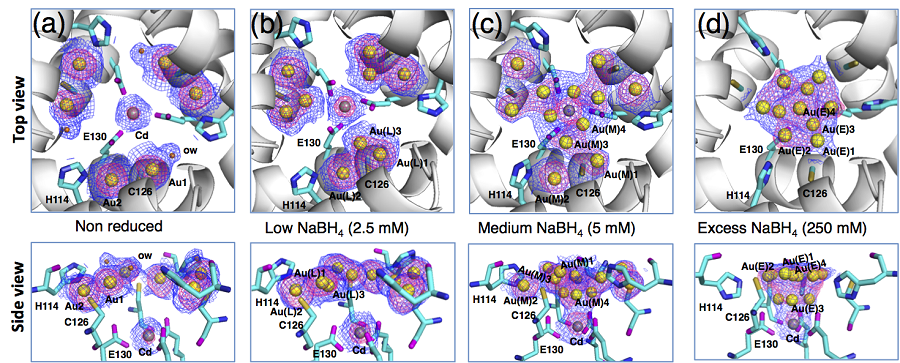結晶性タンパク質ケージ内における金サブナノクラスター核形成観察
Observation of gold sub-nanocluster nucleation within a crystalline protein cage
2017年3月16日 Nature Communications 8 : 14820 doi: 10.1038/ncomms14820

タンパク質は、バイオミネラリゼーション過程を促進する特異な金属配位環境を提供する。タンパク質分子の機能化技術の発展により、生物医学や材料科学に応用可能な無機ナノ材料を作製できると予想される。多くの応用利用が可能にもかかわらず、タンパク質環境中での金属ナノ粒子形成の詳細な機構を明らかにすることは困難である。我々は本研究で、還元反応によるタンパク質内での金属サブナノクラスター形成を構造的に検討するために、アポフェリチン単結晶の架橋処理により、金属還元反応を追跡可能な結晶性タンパク質ケージを作製した。結晶構造解析によって、Auイオンがタンパク質ケージの三回対称チャネルの中心に向かって徐々に移動してサブナノクラスターを形成し、この過程においてAuイオンに結合したアミノ酸残基の顕著なコンフォメーション変化が起こることが示された。これらの結果は、金属核形成の理解や金属核とタンパク質環境との相互作用の理解に役立つと期待される。
Corresponding Author
Protein scaffolds provide unique metal coordination environments that promote biomineralization processes. It is expected that protein scaffolds can be developed to prepare inorganic nanomaterials with important biomedical and material applications. Despite many promising applications, it remains challenging to elucidate the detailed mechanisms of formation of metal nanoparticles in protein environments. In the present work, we describe a crystalline protein cage constructed by crosslinking treatment of a single crystal of apo-ferritin for structural characterization of the formation of sub-nanocluster with reduction reaction. The crystal structure analysis shows the gradual movement of the Au ions towards the centre of the three-fold symmetric channels of the protein cage to form a sub-nanocluster with accompanying significant conformational changes of the amino-acid residues bound to Au ions during the process. These results contribute to our understanding of metal core formation as well as interactions of the metal core with the protein environment.

